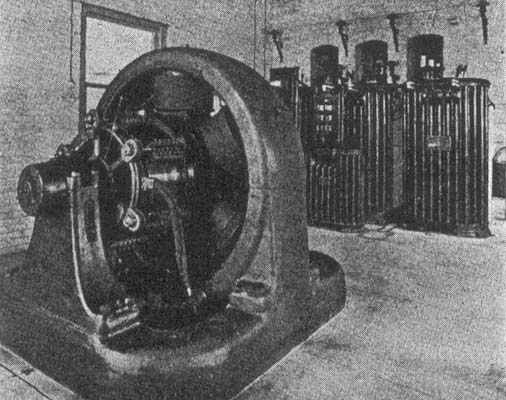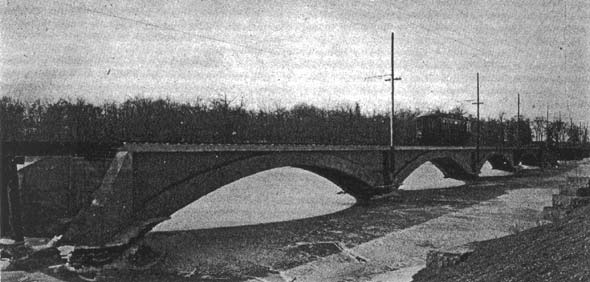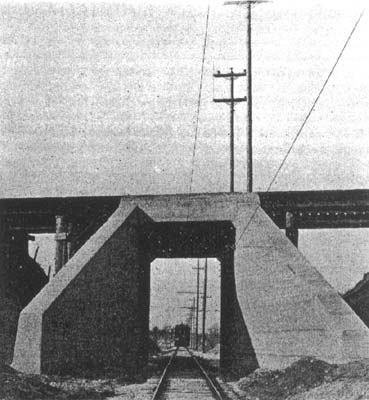[Trade Journal]
Publication: Western Electrician
Chicago, IL, United States
vol. 40, no. 15, p. 319, col. 2-3
EIgin-Beividere Electric Railway.
The Elgin and Belvidere electric railway, a 36-mile interurban road in Northern Illinois, was formally opened in February. Details of the construction of the line were given in the Western Electrician of July 7, 1906. At Elgin the road connects with the Aurora, Elgin and Chicago Railway, a third-rail line. At Belvidere connection is made with the Rockford and Interurban Railway running from Rockford to Freeport, Ill. A line north from Rockford is operated by the Rockford, Beloit and Janesville Railroad. It is proposed to extend this road to Madison, Wis. It is possible that a line will be constructed from Marengo to Harvard connecting with the Chicago, Harvard and Geneva Lake Railway, thus connecting Chicago with Geneva Lake.
| |||
| Sub-Station Interior, Elgin-Belvidere Electric Railway. |
The Elgin and Belvidere Railway touches a number of small cities and villages located in a very prosperous and thriving part of Illinois. It runs almost parallel with the Chicago and Northwestern Railroad tracks, and it is built almost entirely on private right-of-way, 50 feet wide. The country as a rule is level. There are several long tangents, one being seven miles long, which will aid materially in maintaining a fast schedule. The maximum grade of the road is two per cent. The track is composed of 70-pound T rails in lengths of 33 feet, resting upon 6 by 8-inch by 8-foot ties, mostly of cedar.
| |||
| Kishwaukee Bridge, Elgin-Belvidere Electric Railway. |
A feature of the road construction is that there are no grade crossings with railroads. One of the accompanying illustrations shows a subway at the Chicago, Milwaukee and St. Paul Railway crossing, near Almora. It is of concrete construction and is 43 feet long and 14 feet wide. The trolley is supported from mine hangers attached to a wooden trough. The trolley feeders and telephone lines in the subway are arranged on brackets attached to the walls near the roof, the high-tension lines being carried over the track and telegraph lines of the railroad company.
A picture of the bridge over the Kishwaukee River is given. This bridge is of the ribbed concrete-steel type. It has four arches, each of which is 87 1/2 feet long.
| |||
| Elgin-Belvidere Electric Railway. — Subway at Railroad Crossing. |
Electric current for the operation of the road is obtained from the power house of the Aurora, Elgin and Chicago Railway at Batavia. The current is taken from that company's Clintonville substation, located about four miles south of Elgin. Three-phase 25-cycle alternating current at 26,400 volts is carried over the high-tension transmission system to the sub-stations along the line at Gilberts, Union and Garden Prairie, where the current is transformed to 600 volts direct current, distributed through low-tension feeder wires.
The overhead construction is of the bracket type, except through towns where it is necessary to employ cross suspension. The high-tension feeder, telephone and trolley wires are all carried on the same pole, the poles being 40 feet high and spaced 100 feet apart. The high-tension cables are equivalent in conductivity to No. 6 hard-drawn copper and are attached to Locke insulators of glazed porcelain. The low-tension feeder cable is of 300,000 circular mils section. The telephone line is of hard-drawn copper wire of No. 12 B. & S. gauge. Transposition of the telephone wires is effected at every fifth pole.
A lightning arrester is installed on every twentieth pole and mounted in a weatherproof box.
Approximately the same electrical equipment is used in the three sub-stations along the line. Each sub-station contains one 300-kilowatt 25-cycle three-phase General Electric rotary converter, which receives the current at 370 volts alternating and delivers it at 600 volts direct current. Three 110-kilowatt transformers are installed in each station. An oil-cooled reactance coil of 45 kilovolt-ampere capacity is part of each equipment. The switch-boards comprise an outgoing panel, a direct-current rotary converter panel, two direct-current feeder panels, a direct-current voltmeter, a starting panel and two lightning-arrester apparatus. In one of the accompanying illustrations is shown the rotary and transformer in the Garden Prairie sub-station.
The passenger cars used on the Elgin and Belvidere line are of the Pullman double-truck single-ended vestibule type and are approximately 47 feet long, 8 1/2 feet wide and 9 feet 4 inches high. The heating apparatus in each car is located in the smoking compartment. The motor equipment consists of four 74-horsepower motors, with parallel controllers. The lighting consists of 25 incandescent lamps.
The running time between Elgin and Belvidere (36.5 miles) is one hour and 45 minutes, and this is expected to be reduced to 1 1/2 hours. An hourly schedule is now being maintained in both directions. The operating office of the company is at Marengo, Ill., superintended by Mr. George F. V. Faber.
The engineering and construction work for the road was in charge of The Arnold Company, Chicago, under the supervision of, George A. Damon, managing engineer; George Weston, civil engineer; E. N. Lake, electrical engineer, and W. H. Rosecrans, superintendent of construction.



